Excerpts from Jim Conrad's
Naturalist Newsletter
from the January 21, 2018 Newsletter issued from Rancho Regenesis in the woods ±4kms west of Ek Balam Ruins; elevation ~40m (~130 ft), N20.876°, W88.170°; north-central Yucatán, MÉXICO
ALDAMAS FLOWERING
Nowadays biking between the rancho and Ek Balam is a delight because of the superabundance of densely packed, yellow flowered Sunflower Goldeneyes forming walls along both sides of the road up to ten-ft-high (3m). Our page about Sunflower Goldeneyes with information and pictures is at www.backyardnature.net/yucatan/viguiera.htm
Often, down at the bottom of the Sunflower Goldeneyes there are groupings of plants with stems, leaves and flowering heads very similar to Sunflower Goldeneyes, but with flowering heads only about 1/3 the size, and bearing similarly smaller stems and leaves. Moreover, if you look at these smaller plants' flowering heads, you see anatomical differences, too. It's a different species, so easy to overlook in this roadside show staged overwhelmingly by Sunflower Goldeneyes. Below, you can see a branch of this smaller but similar species:
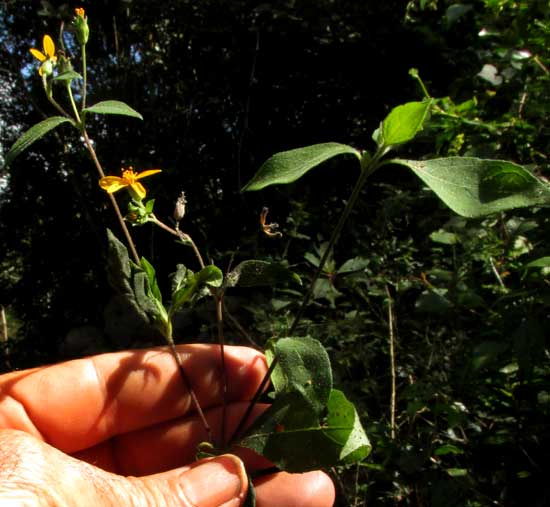
Close-up, you begin seeing how this plant is different from Sunflower Goldeneyes, as shown below:
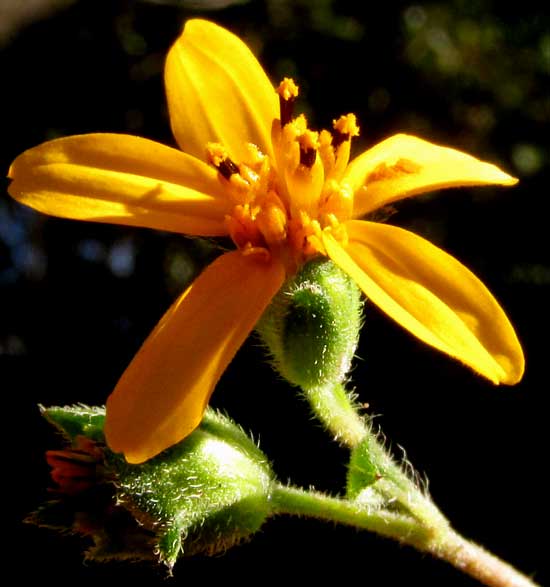
Not only are this species' flower heads much smaller, but also they lack the Goldeneye's broad, golden eye. The eye is yellow, but with fewer disc flowers -- more correctly called "florets" -- with the disc florets' blackish anthers disrupting the "golden eye" pattern. Also, beneath the Goldeneye's head the bowl-like involucre involucre is composed of several series of overlapping green scales or bracts. This smaller species' bracts are arranged in only two or three series, as seen below:
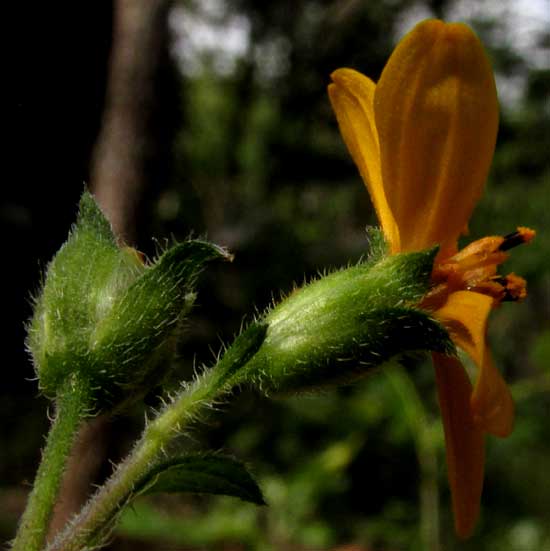
The world of yellow-flowered members of the Composite/Daisy/Sunflower Family, the Asteraceae, is so vast that from the beginning the indentifier knows that one must "do the botany." It's essential to break open a flowering head and see what things look like inside. Our small species' open head is shown below:
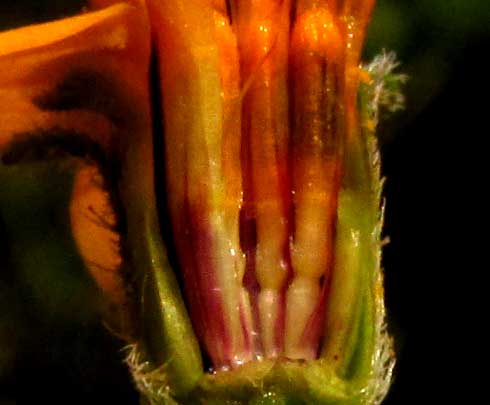
The three vertical items are disc florets with immature, white, bottle-shaped ovaries at the bottoms. The spectacular field mark to notice here is that each floret is nearly entirely wrapped around by and kind of bract called the palea, and the paleae are raspberry colored. Many kinds of yellow composite flowers don't produce paleae at all, and very seldom do raspberry colored paleae almost wrap around the floret ovaries. Also, atop the ovaries of composite florets you may or may not find a "pappus," which can come in many forms. Often the pappus, when present, consists of slender, white hairs, other times they form low crowns, or long or short spines. In this species, the pappus consists of a low crown of scales accompanied by short, broad-based spines called awns.
When this smaller species' flowers are pollinated, the yellow corollas of both disc and ray florets fall off, and when you break open one of these almost-matured heads, you see what's revealed below:
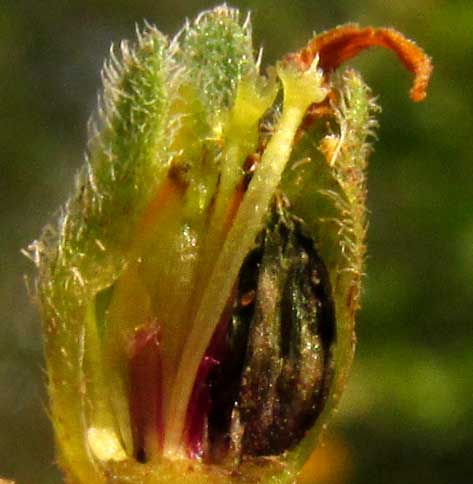
The large black item on the right is a cypsela-type fruit. The head's petal-like ray flowers are sterile, producing no cypselae, so this cypsela is the product of a disc floret.
All these details ultimately led us to WEDELIA ACAPULCENSIS, occurring from the US south-central states throughout Mexico and Central America to about Colombia. This species is so similar to so many other yellow-flowered members of the Aster Family, and there's no study of the family in the Yucatan, that I needed iNaturalist specialist in Mexican Aster Family members "oscargsol" to help with the ID.
from the February 11, 2018 Newsletter issued from Rancho Regenesis in the woods ±4kms west of Ek Balam Ruins; elevation ~40m (~130 ft), N20.876°, W88.170°; north-central Yucatán, MÉXICO
NEGRITA'S FAVORITE WEED-NIBBLE
Often the rancho's dogs can be seen eating dirt and nibbling on vegetation. One assumes the dirt provides minerals that may be missing in their regular dogfood diet, and the plants they eat might be medicinal. For awhile I've been noticing that Negrita the black dog never passes a certain weed without stopping for a nibble, so this week as we approached that weed I got the camera ready so, below, you can see her at work:
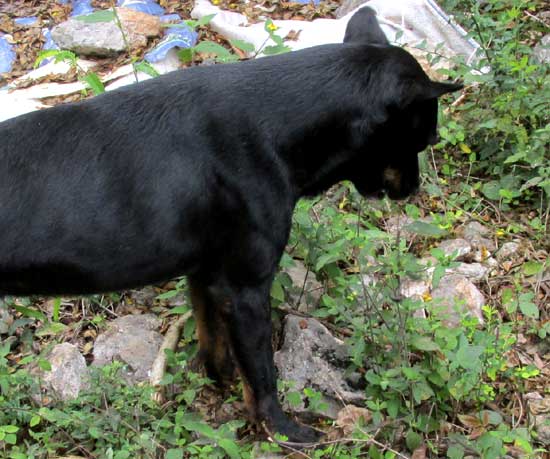
In the past I couldn't identify to species level the typically flowerless and fruitless herbs eaten by dogs, and without an identification there's nothing noteworthy about saying that a dog has eaten a weed. This time, however, when I went to see what she'd been eating, it turned out to be a species we looked out just last month, the Composite or Sunflower Family member WEDELIA ACAPULCENSIS.
So, what does WEDELIA ACAPULCENSIS offer that's so seductive to Negrita that she can't pass it without nibbling on it? On the Internet I find that anthropologist Alejandro Magaña found the Chontal Maya in Mexico's Tabasco state fusing WEDELIA ACAPULCENSIS to deal with high cholesterol. But that didn't seem likely to account for Negrita's fondness of the plant.
Crushing a leaf brought forth no particular odor, and it tasted like any ordinary leaf. However, in tasting it, I did experience one notable sensation, and that is that the leaves were very rough on the lips and tongue. Looking at a leaf surface with a hand lens revealed what's shown below:
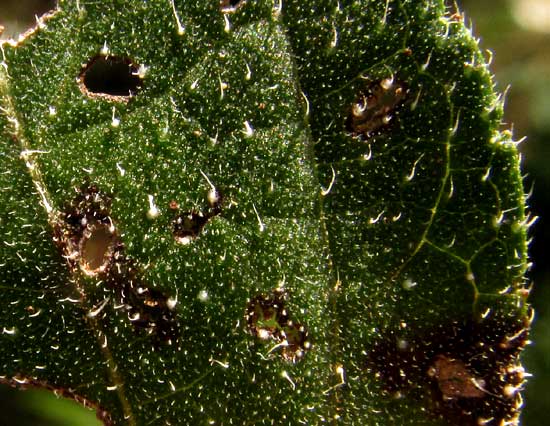
At the microscopic level, the leaves are armored with stiff, sharp, broad-based hairs looking like they could rip into the soft belly of a munching caterpillar or, for that matter, discomfit any leaf-munching invertebrate. Maybe these sharp hairs would wreak havoc on a dog's population of intestinal worms.
At the Pets.WebMD.COM webside I found a discussion on why dogs eat grass. That topic might bear on Negrita's behavior because often grassblades are similarly equipped with sharp, stiff hairs. It's suggested that dogs may eat grass to cause themselves to vomit, though less that 25% of dogs who eat grass vomit after "grazing." Other suggested reasons for eating grass included improving digestion, treating intestinal worms, or fulfilling some unmet nutritional needs, such as the need for fiber. Also, possibly certain dogs simply like how grass tastes or feels.
Of those possibilities, I think the most likely reason for Nigrita habitually eating scratchy WEDELIA ACAPULCENSIS leaves is to help control intestinal worms.